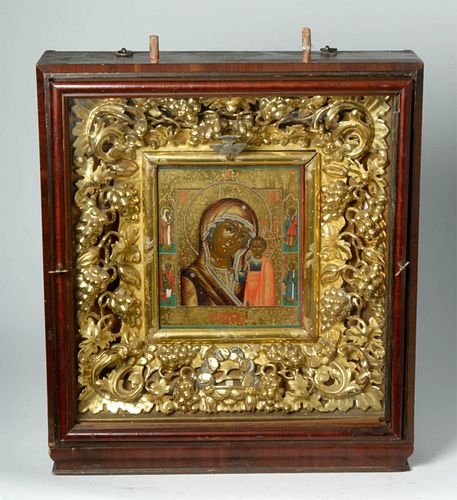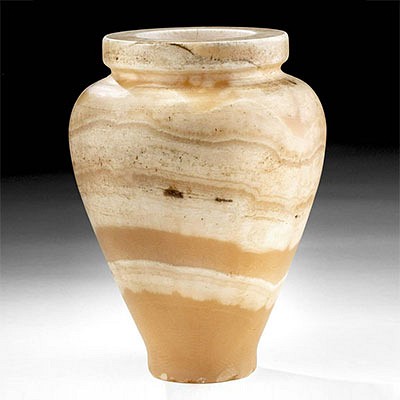19th C. Russian Icon Gold Leaf Kiot Virgin Hodegetria
Lot 167a
About Seller
Artemis Gallery
686 S Taylor Ave, Ste 106
Louisville, CO 80027
United States
Selling antiquities, ancient and ethnographic art online since 1993, Artemis Gallery specializes in Classical Antiquities (Egyptian, Greek, Roman, Near Eastern), Asian, Pre-Columbian, African / Tribal / Oceanographic art. Our extensive inventory includes pottery, stone, metal, wood, glass and textil...Read more
Categories
Estimate:
$3,000 - $4,000
Absentee vs Live bid
Two ways to bid:
- Leave a max absentee bid and the platform will bid on your behalf up to your maximum bid during the live auction.
- Bid live during the auction and your bids will be submitted real-time to the auctioneer.
Bid Increments
| Price | Bid Increment |
|---|---|
| $0 | $25 |
| $300 | $50 |
| $1,000 | $100 |
| $2,000 | $250 |
| $5,000 | $500 |
| $10,000 | $1,000 |
| $20,000 | $2,500 |
| $50,000 | $5,000 |
| $100,000 | $10,000 |
| $200,000 | $20,000 |
About Auction
By Artemis Gallery
Dec 17, 2020
Set Reminder
2020-12-17 10:00:00
2020-12-17 10:00:00
America/New_York
Bidsquare
Bidsquare : VARIETY SALE | Antiquities & Ethnographic Art
https://www.bidsquare.com/auctions/artemis-gallery/variety-sale-antiquities-ethnographic-art-6207
Featuring classical antiquities, ancient and ethnographic art from cultures encompassing the globe. Egyptian, Greek, Roman, Etruscan, Near Eastern, Asian, Pre-Columbian, Native American, African / Tribal, Oceanic, Spanish Colonial, Russian, Fossils, Fine Art, more! Artemis Gallery info@artemisgallery.com
Featuring classical antiquities, ancient and ethnographic art from cultures encompassing the globe. Egyptian, Greek, Roman, Etruscan, Near Eastern, Asian, Pre-Columbian, Native American, African / Tribal, Oceanic, Spanish Colonial, Russian, Fossils, Fine Art, more! Artemis Gallery info@artemisgallery.com
- Lot Description
Eastern Europe, Russia, ca. 19th century CE. Beautifully painted in egg tempera and gold leaf on wood, this Russian icon presents the Virgin Hodegetria ("She who shows the way"), the composition depicting the Mother of God holding the Christ child in one arm, as he makes a blessing gesture. On her shoulders and head, Mary wears a triple, star-shaped cross, which is an ancient Syrian symbol of her virginity - before, during, and following the birth. The four figures depicted in the surrounding border probably represent the bishop of the church and the patron saints of the people who commissioned the painting. The icon is set in a decorative glass-fronted wood kiot with an ornately carved and gilded liner of high relief grapevines dripping with clusters of the fruit of the vine. A silver dove representing the Holy Ghost with finely delineated plumage adorns the center of the upper panel of the liner. Size: 29.25" W x 33.25" H (74.3 cm x 84.5 cm)
Note that in this composition, the artist only depicted Mary's head and shoulders, in concordance with tradition. This invites and prompts the viewer to gaze upon Christ with the subtle inclination of Mary's visage, particularly given those expressive eyes. The Christ Child is characteristically depicted in a rigid, vertical pose - wearing regal vestments. Gold leaf highlights and stunning faux enamelwork accentuate various areas of the composition, and a lavish use of gold leaf in the background bestows a glow to the painting that is picked up in the stunning gilded liner. This use of golden hues, the serene and regal countenance of Mary's face, as well as the pantomime-like gestures reference classic Byzantine splendor; while the lush grapevines reflect the abundance of the Baroque era.
A lovely example inspired by the icon of the Hodegetria that arrived in Constantinople from Jerusalem, where it was found in the 5th century by the sister-in-law of Emperor Theodosius II. According to Alfredo Tradigo's "Icons and Saints of the Eastern Orthodox Church" (2004), "Hidden from the Iconoclasts in a wall at the Hodegon Monastery, it was later carried to the city walls when Constantinople lay under siege and became, under the Palaiologan dynasty (1261-1453), a major palladium protecting the capital. Copies made their way to Rome, the Near East, the Balkans, and Russia." (Tradigo, Icons and Saints of the Eastern Orthodox Church, p. 169)
The wood kiot is a case that protects the icon from smoke and dust as well as temperature and humidity variations to some extent; however, it also serves to enhance and add ornament to the icon. This example in particular with its ornately carved and gilded liner bestows the icon with glorious splendor.
Icons were some of the first religious artworks brought to Russia from Byzantium. These sacred pictures reached a high point in the Byzantine era, however, the Russians brought their own style to the art of the icon. Icons were initially created for use in churches and processions. In time they became smaller and were used increasingly within households. This example, given its large scale, was probably intended for a church. To this day, icons remain an important form of visual culture in Russia's orthodox religious community. Icons (icon means "image" in Greek) are sacred objects within the Eastern Orthodox Christian tradition. These painted images depict holy persons and saints as well as illustrate scenes from the Scriptures. Some icons, like this example, are encased in precious metal covers (oklads) and glass-fronted wooden cases (kiots). Icons are not worshiped, but are instead venerated for their ability to focus the power of an individual's prayer to God. As such they are truly "windows into heaven."
Provenance: private Francis & Lilly Robicsek Collection, Charlotte, North Carolina, USA, acquired second half of the 20th century
All items legal to buy/sell under U.S. Statute covering cultural patrimony Code 2600, CHAPTER 14, and are guaranteed to be as described or your money back.
A Certificate of Authenticity will accompany all winning bids.
We ship worldwide and handle all shipping in-house for your convenience.
#119617Expected surface wear with gilt and paint losses as shown. Gilded liner shows surface wear with gilt losses and a missing ornament on the lower section. Kiot is serviceable, but shows surface wear/losses; dowels inserted to the upper section of the kiot suggest it once had an ornament. Old metal loops on top of kiot. Wood on verso shows wear commensurate with age.Condition
- Shipping Info
-
All shipping is handled in-house for your convenience. Your invoice from Artemis Gallery will include shipping calculation instructions. If in doubt, please inquire BEFORE bidding for estimated shipping costs for individual items.
-
- Buyer's Premium



 EUR
EUR CAD
CAD AUD
AUD GBP
GBP MXN
MXN HKD
HKD CNY
CNY MYR
MYR SEK
SEK SGD
SGD CHF
CHF THB
THB



















